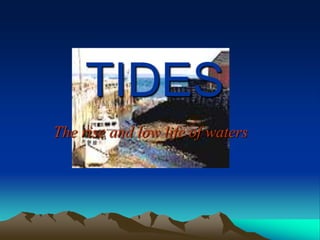
Tides by rockredstar
- 1. TIDES The rise and low life of waters
- 2. What is Tides? Are motions caused by the gravitational attraction between earth, moon, and sun. The periodic motion of the waters of the sea, caused by the attractive forces of the moon and the sun.
- 3. Tides and the Moon
- 4. Tides and the Moon Lunar tides
- 5. Tides and the Moon Lunar tides occur at every 12 hours and 48 minutes, alternating between Moon side and far side high tides with lunar low tides in-between as reference.
- 6. Tides and the Moon Lunar tides occur at every 12 hours and 48 minutes, alternating between Moon side and far side high tides with lunar low tides in-between as reference. Water level highs and lows lag the tide causing forces by 1-3 hours. Large amounts of water must flow long distances around uneven land masses
- 7. Tides and the Sun
- 8. Tides and the Sun Solar tides Smaller and occur at different times than lunar tides The solar high waters are about 12 hrs. apart as the earth rotates on its axis The solar semidaily tide is only 46% that of the lunar semidaily tide.
- 9. Combined effects of Sun and Moon
- 10. Combined effects of Sun and Moon Spring Tides
- 11. Combined effects of Sun and Moon Spring Tides are the highest tides we have which occur twice each month during the full moon (when the sun and the moon are in line with the earth)
- 12. Combined effects of Sun and Moon Spring Tides are the highest tides we have which occur twice each month during the full moon (when the sun and the moon are in line with the earth) Neap Tides
- 13. Combined effects of Sun and Moon Spring Tides are the highest tides we have which occur twice each month during the full moon (when the sun and the moon are in line with the earth) Neap Tides it is when tides are at their lowest, occur during the first and third quarter moon (when the sun and the moon are at right angles)
- 15. Another kinds of Tides
- 16. Another kinds of tides Perigean Tides
- 17. Another kinds of tides Perigean Tides Like other heavenly bodies, the moon's orbit around the Earth is elliptical. Once each month, the moon passes by the Earth at perigee, which is about 30,000 miles closer than at apogee, or the furthest point in orbit.
- 18. Another kinds of tides Perigean Tides Like other heavenly bodies, the moon's orbit around the Earth is elliptical. Once each month, the moon passes by the Earth at perigee, which is about 30,000 miles closer than at apogee, or the furthest point in orbit. When spring tides and perigee align, the moon's extra-strong pull results in unusually high tides, known as perigean tides. Perigean tides take place at intervals that are slightly longer than six months, according to the Woods Hole Oceanographic Institution.
- 19. Another kinds of tides Diurnal Tides
- 20. Another kinds of tides Diurnal Tides If one high tide and one low tide take place in a lunar day, it's known as a diurnal tide. Diurnal tides create 24-hour, 50-minute tidal periods.
- 21. Another kinds of tides Diurnal Tides If one high tide and one low tide take place in a lunar day, it's known as a diurnal tide. Diurnal tides create 24-hour, 50-minute tidal periods. Oceans in partially enclosed basins, such as the Caribbean and the Gulf Coast of the U.S. often experience diurnal tides.
- 22. Another kinds of tides Semi-Diurnal Tides
- 23. Another kinds of tides Semi-Diurnal When two high and two low tides of the same height take place in a lunar day, it's called a semi-diurnal tide.
- 24. Another kinds of tides Semi-Diurnal When two high and two low tides of the same height take place in a lunar day, it's called a semi-diurnal tide. Semi-diurnal tidal periods are 12 hour and 25 minutes long. Most coastlines experience semi-diurnal tides.
- 25. Another kinds of tides Mixed tides
- 26. Another kinds of tides Mixed tides where successive high-water and low-water stands differ appreciably .
- 27. Another kinds of tides Mixed tides where successive high-water and low-water stands differ appreciably . In these tides, we have a higher high water and lower high water as well as higher low water and lower low water.
- 29. THANK YOU AND GOD BLESS US! By Rochelle D. Bernas
